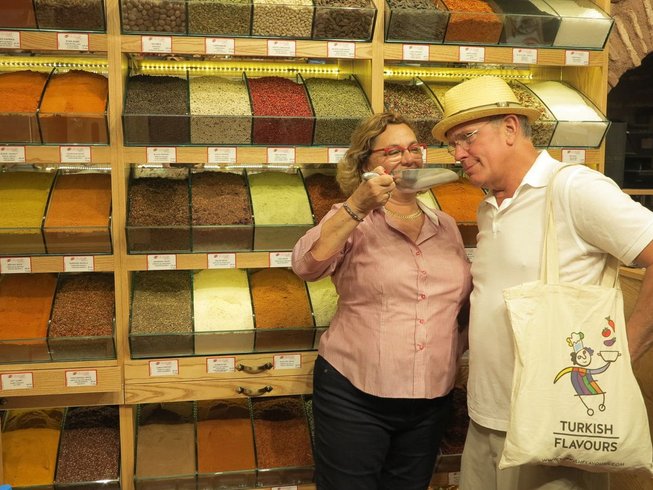Meals as specified in the itinerary (daily breakfast, 7 lunches and 6 dinners) are included in the package.
Everywhere you turn in Turkey, there is something delicious to eat, including street food such as bread rings covered in sesame seeds, deep-fried mussels with a garlic-rich sauce, warm roasted almonds and pistachio nuts, pastries bathed in syrup, divine milky desserts, and chewy ice creams.
In the many restaurants and street caf?s, you can dine in style eggplants stuffed, grilled, or fried in endless ways; tangy salads and yoghurt dips strongly flavoured with garlic. Every town and city has a market where you will find a wealth of fresh seasonal produce, such as plump olives and crunchy pickles, fresh figs, ruby red pomegranates, juicy ripe peaches, pungent spices, and fresh leafy herbs, which are sold like bunches of flowers.
Culinary tradition
While the food and cooking of Turkey is inevitably shaped by its diverse geography and climate, it could be said that the countrys turbulent history has also played a key role in shaping the cuisine. Constantly in flux, the culinary traditions embody the many cultures that have had an impact on Turkish life over the centuries. These include ancient Persian and Arab practices that have been handed down from generation to generation, the influences of Islam and the Ottoman Empire and today, the growth of urbanization and tourism.
The dishes in Turkish cuisine roughly can be classified as follows:
- Soups: wheat and derivatives, rice legumes, seasonal vegetables, yoghurt are used
- Mezes, appetizers: this list is endless - it can be a slice of melon with white cheese, beans cooked with olive oil, garlic and parsley, stewed mussels, black olives, boiled potato salad, tomato salad with roasted eggplants, bulgur salad, phyllo cheese rolls, and more
- Fish and seafood: Turkey is surrounded by the seas on three sides. All kinds of fish from these three seas are consumed by either grilling, frying, baking, or steaming depending on their variety
- Poultry: Nowadays cooks try to substitute chicken with red meat since scientists say white meat is healthier. However, in olden times tasty free-range chickens were boiled; the chicken broth was to make delicious pilav or rice, and the pieces of chicken were served with it. Or boiled chicken garnished with walnut sauce, or chicken stuffed with rice, liver, currants and pine nuts
- Meat: it is either consumed in grilled form alone or grilled with some vegetables or fruits such as eggplants, quinces, onions, garlic, loquats, and apples depending on the season and called kebabs, or it can be cooked with vegetables or fruits in a pan called stews or yahni
- Vegetables: any seasonal fresh one or two kinds of vegetable is cooked with the addition of olive oil
- Dolma, stuffed vegetables: zucchinis, eggplants, tomatoes, bell peppers, are stuffed with rice or with bulgur; one may add ground meat to the stuffing if she likes; vine leaves, Swiss chard or cabbage leaves are wrapped up with the same stuffing
- Pilavs; mostly rice is used, but in folk cuisine bulgur is used due to availability. Either rice or bulgur is used. The pilav is always enriched by the addition of one or two of the following ingredients, onions, tomato, currants, pine nuts, chestnuts, zucchini, eggplants, meat, liver, and more
- Noodles and pasta dishes: homemade vermicelli and noodles are still prepared in Anatolian provinces. Manti, a kind of dumpling or ravioli, is prepared by rolling out dough thin enough, cutting the rolled pastry into one inch squares, filling in the centre with ground meat or chickpea size, pinching to seal, boiling, then serving with yoghurt-garlic sauce with butter-paprika topping.
- Breads, and boreks: Mostly with wheat, in rural areas with other grains. Pita, tandir (clay oven) bread, flat bread (unleavened) baked on sac (griddle) are some kinds. Olives, walnuts, tahini, cheese, and meat are often added to bread for flavour and texture. Boreks are prepared by rolling out the dough with the rolling pin into desired size circle and filled with either cheese-parsley mix, or ground meat onion mix, or spinach, and shaped into thin packets of pastry, and fried. Or as in lasagna, rolled-out thin dough is layered with different fillings mentioned above, and baked in the oven
- Desserts: can be dough or flour-based, milk-based, fruit-based, or rice-based. These desserts can be enriched-flavoured by the addition of one of them; pistachio nuts, walnuts, rose water, saffron, cinnamon, cloves cheese or clotted cream.
- Drinks; ayran diluted yoghurt drink, liquorice tea, fruit-based drinks or sherbets such as rose, lemon, orange, sour cherry; tea, coffee and herbal teas such as linden tea, mint tea, boza; a fermented (of ground wheat, barley or millet) soup-like beverage, salep; a drink prepared by milk, sugar and a starchy powder made by drying and pulverizing the root tubers of certain plants of the orchid family, orchis latifolia.
The products people mostly use which are common to all the Mediterranean countries are olive oil, olives, cheese, fish, tomato, pepper, eggplant, zucchini, pine nuts, walnuts, basil, parsley, coriander, paste, noddles, sausages, orange, lemon, honey legumes, and grains.
The following meals are included:
The following dietary requirement(s) are served and/or catered for:
- Regular (typically includes meat and fish)
If you have special dietary requirements it's a good idea to communicate it to the organiser when making a reservation






















Add a review